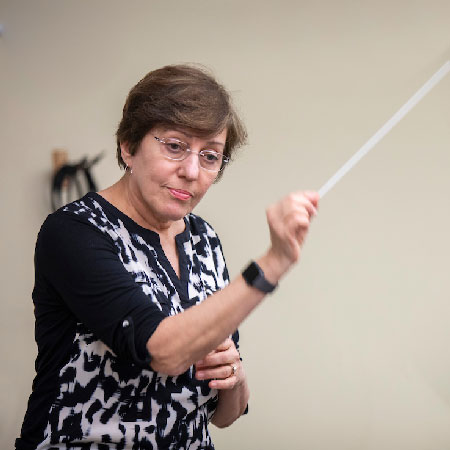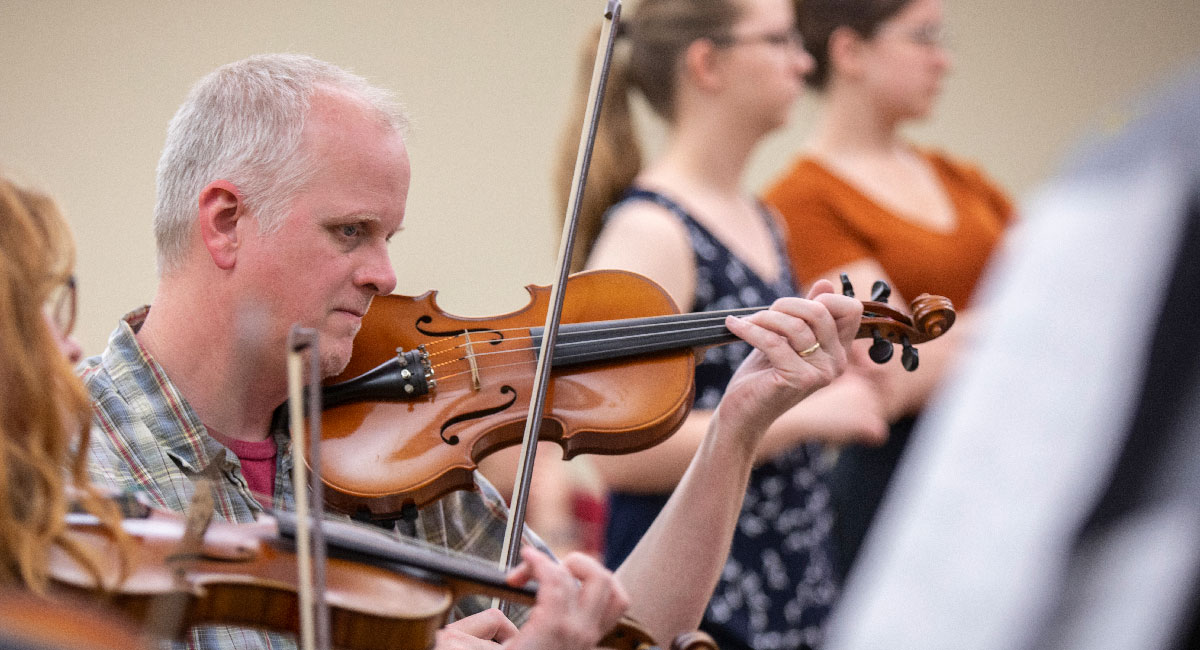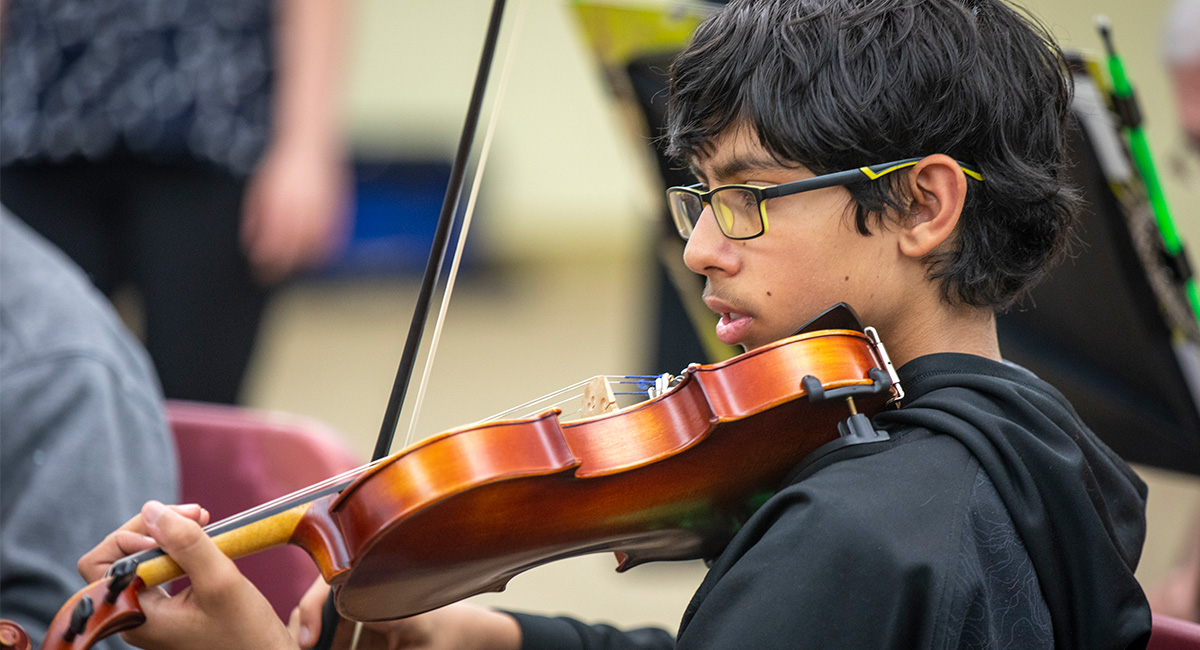'The gold standard'
Music program serves SC schools, trains next generation of teachers
Posted on: May 29, 2019; Updated on: May 29, 2019
By Megan Sexton, msexton@mailbox.sc.edu, 803-777-1421
Having a conversation with people connected to the University of South Carolina String Project has the feel of a family reunion whose members are scattered across the state and the country, each one chiming in with a story to tell.
They talk about how the String Project, a nationally recognized program of instruction in violin, viola, cello and bass for nearly 45 years, has changed their lives, their students’ lives and their students’ students’ lives. There’s a familiar refrain in their stories about how the program is not only a music class but also a community service and teacher education model that has been duplicated at about 40 other universities around the country.

During the 22 years Gail Barnes has been director of the String Project, she has graduated 115 teachers, most of whom are still teaching music around the state and the country. This year, she received the American String Teachers’ Association’s researcher award for long term achievement.
They sing the praises of the pipeline of college students, high school orchestra leaders and university string project directors who are making music and an impact every day. Their stories blend teaching excellence, musical talent and a commitment to access and affordability — all with a really good soundtrack.
There are the high school and private lesson string teachers who learned their craft in the rehearsal classrooms at South Carolina, and who now are instructing their own students around the state and the country. There are university music professors in states such as Illinois and Arizona, who have started or continued string projects at their colleges, all modeled after the successful program in Columbia, South Carolina.
And intersecting with all the family members is Gail Barnes, who took over the USC String Project 22 years ago, and who this year was honored by the American String Teachers' Association with its String Researcher 2019 Award for Long Term Achievement. Barnes received the award for her sustained engagement in research activities including publication in juried research journals, research presentations at professional meetings, professional service in string research, and support — including mentoring, collaboration and supervision — of other string researchers.
“The String Project is a win-win model of community service and teacher education.
This is my 22nd year as director, and I find new layers to the program all the time,”
Barnes says. “We have evolved as we’ve gone on because families change, the community
changes, but at this point I’ve graduated 115 teachers. Most of them are out there
teaching music one way or another. And I’m really happy with the work I see, not only
in this community, but I have students who are teaching in Virginia, Georgia, Arizona,
New York — it’s a wide geographic range.”
The first notes
The USC String Project serves the Midlands community and, at the same time, gives university students the chance to get an early taste of teaching in a paid, pre-service teacher education program. Beginning string students start when they are in the third, fourth or fifth grades, and can progress and participate in the program until they graduate from high school. Older students receive private lessons and play in String Project orchestras through high school. Classes for adults also are offered, and String Project teachers are undergraduate and graduate music education students supervised by university faculty members.
The String Project was initiated in 1974 by William Moody, who was head of the university’s School of Music, and directed in the beginning by William Bauer, a violin professor. For 15 years, it was then directed by Robert Jesselson, now a Carolina distinguished professor emeritus and the 2013 Governor’s Professor of the Year. Jesselson, a cello professor, built the String Project into one of the country’s largest and most prominent string education programs.
Theodore “Ted” Buchholz grew up in Columbia and says he started playing the cello a little too late to be involved in the String Project, but he knew the reputation of both the program and of Jesselson.
“The String Project had such an enormous impact on the community, even before I was born. In the public schools I was in [Crayton Middle and A.C. Flora High], the string teacher and the program owed its existence to what Bob Jesselson had done,” Buchholz says. “My mother knew I should work to get in his studio. In ninth grade, I auditioned. It took another year, but in 10th grade he admitted me. His teaching kind of changed my life.”
After high school, Buchholz attended the San Francisco Conservatory of Music, and he now teaches music at the University of Arizona. He also re-established the String Project on the Arizona campus, a program similar in practice to the South Carolina program, that serves 80 children in Tucson, with 11 music education and performance majors teaching the ensemble rehearsal and private lessons.
“Why is it important? I fundamentally believe music belongs in the curriculum the
same way math does,” Buchholz says. “It’s a subject worth studying, not as an extracurricular.
Music teaches us things other subjects don’t. I love math. Music is just as important.
It teaches us how we learn. You get to see the learning process. And then it teaches
motor skills. But more importantly it teaches confidence. Setting goals, realization
of those goals — that’s a life skill that is incredibly important.”

The importance of music education
Beth Reed, executive director of the National String Project Consortium, understands the importance of music and string education, too, and knows first-hand the breadth and scope of South Carolina’s program. When Reed was a student in Columbia’s Richland District One and Lexington One schools, her string teachers came from the university’s music education ranks. Reed earned her bachelor’s and doctoral degrees in music education from South Carolina, and was assistant director of the String Project while she was here.
“For me, it’s very much a full circle, having been part of that program. My freshman year was Gail Barnes’ first year. Then I went off to grad school and then taught in Fairfax County in Virginia for 10 years,” she says. “I definitely attribute my teaching background and the ability to feel successful in my teaching to the opportunities I had in the String Project. I directly am impacted by this and know of its value and worth.”
Now, directing the national consortium that was founded by Jesselson, she has gained a further appreciation for the string program at South Carolina.
“Currently the University of South Carolina String Project is the model for 38 operational sites across the United States,” Reed says.
While not every string project follows the exact model, each keeps the two main goals of supporting public school string programs and making sure there are affordable string programs in the community, whether it’s urban, suburban or rural. It also has helped create the next generation of string teachers, with 395 student-teachers at string project sites over the past five years, an increase of 4 percent since 2014. And, compared to the national standard in terms of diversity of teachers, minorities make up a much higher percentage of string teachers, particularly among the Hispanic and African American populations, Reed says.
“It’s about creating an opportunity for arts education, whether it's music, dance,
fine arts. In the public schools, string education is still under 50 percent in elementary,
middle and high school. In almost every high school there’s a band and choir director,
but (string education is) at 43-44 percent in middle and high schools,” Reed says.
“It’s important to create teachers to help start these programs and increase opportunities
in public schools.
Committed to access and diversity
That commitment to access and diversity has been particularly important to Barnes throughout her career as a music educator. She came to the University of South Carolina 22 years ago after teaching for 18 years in southeastern Virginia public schools, and music has been a part of her life since childhood.
She was at Ohio State University with no intention of applying for another job when her viola teacher showed her the ad for the South Carolina position, saying, “Gail, this is your job.”
“I had taught in an urban school district, and we have a very diverse student body with the String Project, which I love. I believe in the need for social justice and access. It’s been a happy fit,” Barnes says. “I believe the desire for social justice has been a motivating factor throughout my work as a teacher in both public schools and as a professor and director of the University of South Carolina String Project.”
She discussed that importance while accepting her award at the American String Teachers’ Association’s national conference in Albuquerque this year, telling the audience: “This year at the University of South Carolina String Project, 25 percent of the teachers are either African American or Latino. I am thrilled because I know what a positive example that has for our students.”
Barnes also notes that the majority of string teachers are white and middle class, which makes it necessary for all teachers, particularly pre-service teachers, to develop cultural responsiveness.
“To that end, five years ago we formed a partnership with Keels Elementary, a Title I school,” Barnes says. “Alvera Butler, the current principal and former string teacher and String Project alumna, initiated this partnership. She wants her students to have access to string education prior to the district grade start, and I want my students to learn to meet the musical and educational needs of students who have different backgrounds than their own.”

Teaching the next generation
In her time with the USC String Project, Barnes says she has graduated 115 teachers, including Meredith Tashkandi, a teacher at Pelion High School, who earned her music education bachelor’s and master’s degree from South Carolina, with the String Project a big factor in her decision to attend South Carolina in 2007
“I had gotten accepted into a few other colleges and was weighing my options. The one thing that made me decide on USC was the thought that, even before I graduate or student teach, I could have hands-on experience teaching,” Tashkandi says. “Nothing else really compared to that. Even though some other colleges and universities offered me more money to go there, I decided USC was the best fit for me and for what I wanted to do. And it was.”
As an undergraduate she assisted with the String Project, starting her freshman year as an assistant in the beginner class and one of the large orchestras. As a sophomore, she taught private cello lessons, while junior year she co-taught a second-year class. By senior year she was teaching a beginner class and an orchestra. She decided to stay on for her master’s degree, and Barnes hired her as a graduate assistant and assistant director of the String Project.
“Because of my experience at the String Project, both as an undergrad and a master’s student, I was hired when I graduated in Lexington District One. I was teaching at a high school, a middle school and two elementary schools. I was the only teacher in my area,” she says. “Had I not had that experience at the String Project, I would not have been hired for that position.”
By Tashkandi’s third year in the program, the sixth-grade enrollment numbers in the Pelion schools had doubled, and the district added another full-time orchestra teacher. By her fourth year, she went to Pelion High full time, and she now is in her sixth year of teaching strings. Now, she’s watching her own string students follow her footprints and come to the university as music education majors.
She says the USC String Project owes its longevity in the community to the quality of the program and teachers and its commitment to affordability.
“Another thing that contributes to the success of the string project is Dr. Barnes herself. She’s modest, that’s not something she’d say, but she’s such a prolific music educator,” says Tashkandi, who grew up in Greenville. “When we started as freshmen at USC, I don’t think many of us realized what a big deal she is. It wasn’t until I was doing my master’s and conducting my own research that I would come across articles she’d written or articles where she was listed as a resource.”
One of Tashkandi’s former students, Katie Ailes, just finished her freshman year as a South Carolina music education major. She participated in the String Project when she was growing up in rural Lexington County. Her String Project training helped her prepare for college auditions and convinced her that she wanted to attend UofSC.
Now, as a freshman, she assists the teachers in the String Project, making sure the younger students’ instruments are tuned and helping to answer their questions.
“I want to stay in music and I want to teach. There’s so much untapped potential in children.
Coming to USC and seeing the faculty and the String Project helped me solidify that decision,” Ailes says.
And the USC String Project model continues to spread around the country.
Adriana Ransom, a cello professor and director of the string project at Illinois State University, String Project, said the program at her university started in 2001. It was modeled after the South Carolina program, and has grown to serve 140 children a year with about 25 college students as teaching assistants.
“The USC program is still the model the National String Project Consortium uses for
new sites to apply. It’s the gold standard, basically,” Ransom says. “In terms of
class structure and budget, it’s a perfect model for other schools to mimic.”